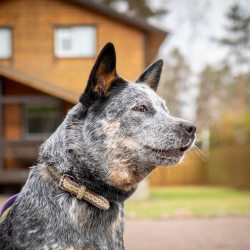advertisement
31 May 2023
Dogs never cease to amaze us with their unique and intriguing qualities. We have gathered 10 of the most unusual and little-known facts about our beloved canine companions. Impress your fellow dog lovers at your next gathering with these fascinating tidbits.
 A Dog’s Nose Print is Unique, Like a Fingerprint
A Dog’s Nose Print is Unique, Like a FingerprintJust as humans have unique fingerprints, dogs have distinct nose prints. Each dog has a pattern of ridges and creases on their nose that is unique to our fingerprints. Kennel clubs worldwide recognize nose prints as a reliable method of identifying dogs, as they remain unchanged over time.
 Dogs Lack Functional Collarbones
Dogs Lack Functional CollarbonesUnlike humans, dogs do not have collarbones or clavicles connecting their shoulders to their torsos. Instead, their shoulder blades attach to the rest of their bodies through muscles and tissues. Dogs possess rudimentary “collarbones” made of cartilage but are small and do not articulate with the skeleton.
 Dogs’ Eyebrows Have Evolved for Expressiveness
Dogs’ Eyebrows Have Evolved for ExpressivenessOver generations of domestication, dogs have developed facial muscles that allow their eyebrows to move in a way that can convey various expressions. This evolution enables dogs to better communicate with humans and elicit emotional responses. So, when your furry friend gives you those irresistible puppy dog eyes, you know they are using their evolved expressions to melt your heart. Check out this post to learn how a dog’s eyes and eyebrows evolved from wolf to dog!
 Rin Tin Tin was nominated for the First Oscar for Best Actor (and almost won)
Rin Tin Tin was nominated for the First Oscar for Best Actor (and almost won)In 1927, the famous German shepherd Rin Tin Tin became a sensation in the film industry, starring in multiple box office hits. As a result, he was nominated for the first Best Actor Oscar for outstanding performances. However, the Academy deemed it inappropriate for a dog to receive such an honor, and the award went to Emil Jannings instead (boo!).
 Dogs Prefer to Poop Aligned with the Earth’s Magnetic Field
Dogs Prefer to Poop Aligned with the Earth’s Magnetic FieldThis one is particularly fascinating! In a peculiar study conducted in 2013, researchers discovered that dogs tend to align themselves along the north-south axis when defecating. This behavior suggests that dogs are sensitive to the Earth’s magnetic field. The exact reasons behind this preference remain a mystery, but it’s a fascinating observation nonetheless.
 Dogs Have Belly Buttons, Although They’re Hard to Spot
Dogs Have Belly Buttons, Although They’re Hard to SpotLike most mammals, dogs have belly buttons remnants of their umbilical cord attachment in the womb. The mother chews the cord, leaving a dried-up stump that eventually falls off. While dog belly buttons may not be as noticeable as human belly buttons, they can be found as oval-shaped scars.
 Bluey: The Oldest Dog on Record
Bluey: The Oldest Dog on RecordBluey, an Australian cattle dog, holds the Guinness World Record for the oldest dog ever. Bluey lived a remarkable 29 years and 5 months, serving as a dedicated herding dog for nearly two decades in Australia. And yes, the beloved children’s show “Bluey” is named after her and makes an appearance as a character!
 The Rarest Dog Breed in the World is the Chinook Breed
The Rarest Dog Breed in the World is the Chinook BreedThe Chinook is a rare sled dog breed originally developed in New Hampshire during the early 1900s. At one point, their population dwindled to only 125 individuals worldwide. Today, the Chinook remains a scarce breed, with approximately 140 puppies born yearly.
 Yawning is Contagious for Dogs Too
Yawning is Contagious for Dogs TooJust like humans, dogs can catch a yawn from others. Research has shown that the sound of a human yawn can trigger a yawn response in dogs. Interestingly, dogs are four times more likely to yawn when it’s someone they know, demonstrating what we all know to be true — dog empathy continues to be off the charts.
 Dogs Can Get Sunburned
Dogs Can Get SunburnedWhile it may surprise some, dogs are susceptible to sunburn. Dogs with short hair, light-colored hair, and fair skin are particularly vulnerable. Therefore, protecting your dog from excessive sun exposure is crucial. You can limit their time in direct sunlight and consult your veterinarian about using dog-friendly sunscreen to safeguard their skin.
Dogs continue to captivate us with their unique characteristics and behaviors. These lesser-known facts shed light on the incredible world of our furry friends. So, the next time you engage in dog-related conversations, impress your fellow enthusiasts with these intriguing tidbits about our beloved companions.
advertisement
advertisement
